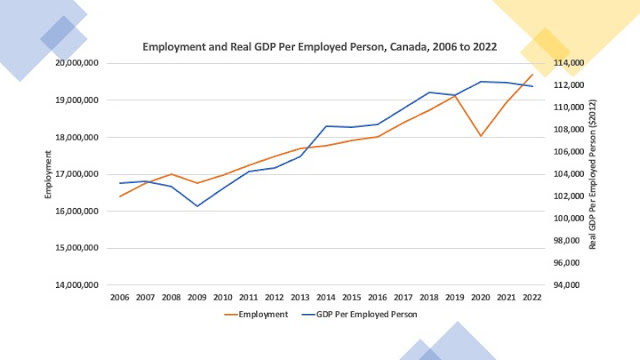Today’s CPI inflation numbers have many breathing a sigh of relief with the expectation that with inflation below 2 percent, more interest rate relief is on the way and Canadians can resume their high personal borrowing lifestyle. Lost in the short-term euphoria and celebration of expected lower borrowing costs is the long term cost that inflation has had on our standard of living given the low productivity gains of the last five decades. Nowhere is this more evident than when one takes a look at how real wages have performed over time.
Figure 1 plots the average annual monthly hourly Canadian manufacturing wage – nominal and real – for the period from 1960 to 2023. The nominal hourly manufacturing wage data and the All-City CPI data are both from the US Federal Reserve of St. Louis data sets [CPALCY01CAA661N; LCEAMN01CAM189S] with the real hourly wage data in $2015. Why manufacturing wages? Well, the manufacturing sector has generally been held up as the beacon for good quality and high paying jobs with a lot of hand wringing as manufacturing jobs have declined as a share of employment. It sounds old fashioned but many still regard manufacturing jobs as the “high ground” of an economy in terms of value added to which I would also add the resource sector (including agriculture).
When nominal hourly wages are examined, their performance looks impressive. The monthly nominal manufacturing wage in Canada in 1960 averaged $1.78/hr. By 2023, it was $30.66/hr and the average annual growth rate of real nominal hourly wages in manufacturing was 4.7 percent. However, when adjusted for inflation using the All-City CPI for Canada with 2015 as the base year, real nominal wages barely double over the period going from $13.64/hr to $24.91/hr. The average annual growth rate of real hourly manufacturing wages over this entire period was only 1 percent annually. Given that at 1 percent annual growth it would take approximately 72 years for a quantity to double, we can expect real hourly wages in manufacturing to be double those in 1960 by 2032.
Figure 2 plots the annual average growth rate of real hourly manufacturing wages and adds a 5th order polynomial smoothing plot. When one examines both Figure 1 and 2, it becomes apparent that the stagnation in real wage growth really sets in during the 1970s. There was a brief uptick in real wage growth in the wake of the FTA and NAFTA (in 1988 and 1994 respectively) but decline sets in again after the 2008-09 financial crisis. When one combines the productivity decline that starts in the 1970s following the first oil price shock with the effects of inflation, the erosion of the standard of living – as captured by real wages – is dramatically illustrated. It makes the case for why bringing inflation under control is so important and also why we need a productivity agenda to drive Canadian policy going into the next election.



